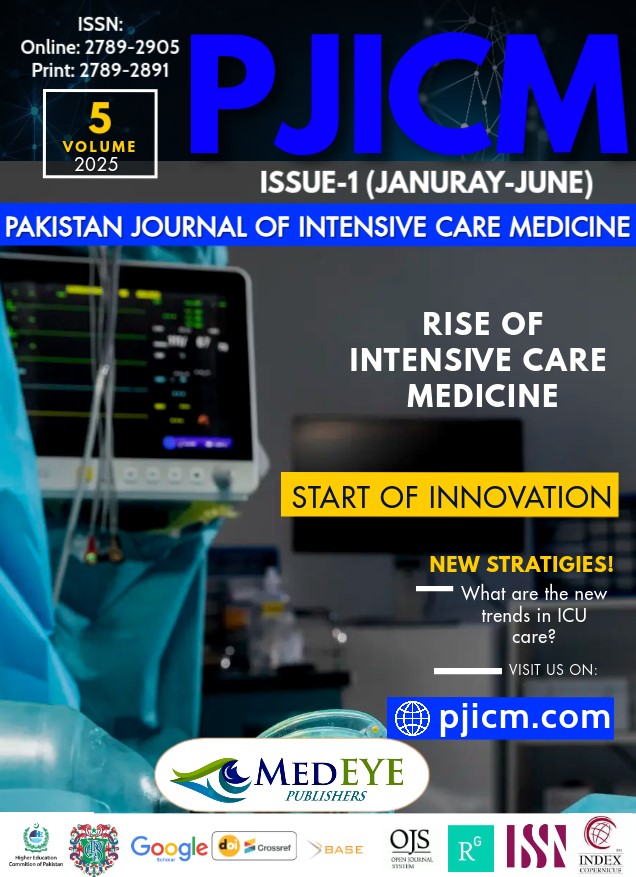ROLE OF MANNITOL IN IMPROVING THE OUTCOMES OF MODERATE TO SEVERE PERINATAL ASPHYXIA
DOI:
https://doi.org/10.54112/pjicm.v5i01.47Keywords:
Perinatal Asphyxia, Mannitol, Mortality, SurvivalAbstract
Background: Birth asphyxia, defined as inadequate oxygen supply to a newborn during delivery, is a major cause of neonatal morbidity and mortality, second only to sepsis. While its incidence in developed countries ranges from 1% to 1.5% of live births, it rises significantly in developing nations, reaching up to 5%. Effective management of moderate to severe birth asphyxia remains a challenge. This study evaluates the efficacy of Mannitol infusion in improving survival outcomes in neonates diagnosed with moderate to severe perinatal asphyxia. Objective: To assess the effectiveness of Mannitol in managing cases of moderate to severe perinatal asphyxia in full-term neonates. Study Design: Case series study. Setting: Department of Pediatrics Medicine, Sughra Shafi Medical Complex, Narowal. Duration of Study: March 2, 2023, to September 1, 2023. Methods: A total of 141 full-term neonates diagnosed with moderate to severe perinatal asphyxia were included using consecutive non-probability sampling. Mannitol 20% was administered intravenously at a dosage of 1.5 mL/kg over 20 minutes every 8 hours. All neonates received standard supportive treatment according to established neonatal care protocols. The primary outcome measure was survival or mortality. Data were analyzed using SPSS version 25.0, and post-stratification analysis was conducted using the Chi-square test, with statistical significance set at p ≤ 0.05. Results: Among the 141 neonates, 91 (64.5%) were males and 50 (35.5%) were females. The mean age was 16.35 ± 6.534 days. Mannitol therapy resulted in a survival rate of 82.3% (116 neonates), while mortality was observed in 17.7% (25 neonates). Conclusion: Mannitol infusion demonstrated promising effectiveness in the management of moderate to severe perinatal asphyxia, significantly improving survival rates. These findings support the potential role of Mannitol as a therapeutic option in neonatal intensive care settings, warranting further large-scale studies to validate its efficacy and safety.
References
Scher MS. “The first thousand days” define a fetal/neonatal neurology program. Frontiers in Pediatrics. 2021;9:683138.
Al Balushi A, Vargas SB, Maluorni J, Sanon PN, Rampakakis E, Saint-Martin C, et al. Hypotension and brain injury in asphyxiated newborns treated with hypothermia. Am J Perinatol. 2018;35(1):31-8.
Lakatos A, Kolossváry M, Szabó M, Jermendy Á, Barta H, Gyebnár G, Rudas G, Kozák LR. Neurodevelopmental effect of intracranial hemorrhage observed in hypoxic ischemic brain injury in hypothermia-treated asphyxiated neonates-an MRI study. BMC pediatrics. 2019;19:1-1.
Lemyre B, Chau V. Hypothermia for newborns with hypoxic-ischemic encephalopathy. Paediatrics & child health. 2018;23(4):285-91.
Nair J, Kumar VH. Current and emerging therapies in the management of hypoxic ischemic encephalopathy in neonates. Children. 2018;5(7):99.
Samaiya PK, Krishnamurthy S, Kumar A. Mitochondrial dysfunction in perinatal asphyxia: role in pathogenesis and potential therapeutic interventions. Molecular and Cellular Biochemistry. 2021;476(12):4421-34.
Frajewicki A, Laštůvka Z, Borbelyova V, Sami KH, Jandová K, Janišová K, et al. Perinatal hypoxic-ischemic damage: review of the current treatment possibilities. Physiological research. 2020;69(3):379.
Roychoudhury S, Esser MJ, Buchhalter J, Bello-Espinosa L, Zein H, Howlett A, et al. Implementation of neonatal neurocritical care program improved short-term outcomes in neonates with moderate-to-severe hypoxic ischemic encephalopathy. Pediatric Neurology. 2019;101:64-70.
Rameshkumar R, Bansal A, Singhi S, Singhi P, Jayashree M. Randomized clinical trial of 20% mannitol versus 3% hypertonic saline in children with raised intracranial pressure due to acute CNS infections. Pediatric Critical Care Medicine. 2020;21(12):1071-80.
Kumaraguru D, Varadarajan P, Sangareddi S, Padmanabhan R, Jeyachandran P. Effectiveness of 3% saline versus mannitol in children with cerebral oedema of non-traumatic etiology. J Pediatr Sci. 2012;4(3):1-6.
Rautaray S S, Sarkar PD, Agrawal BK. Study of the effect of mannitol on serum electrolytes before and after three days in stroke patients. Biomedical Research. 2008;19(3):177-180.
Zornow MH. Hypertonic saline as a safe and efficacious treatment of intracranial hypertension. J Neurosurg Anesthesiol. 2016;8:175-177.
Qureshi AI, SuarezJI, Bhardwaj A, Mirski M, Schnitzer MS, Hanley DF, et al. Use of hypertonic saline/acetate infusion in the treatment of cerebral edema: Effect on intracranial pressure and lateral displacement of the brain. Crit Care Med. 2008;26:440-446.
Suarez JI, Qureshi AI, Bhardwaj A, Williams MA, Schnitzer MS, Mirski M, et al. Treatment of refractory intracranial hypertension with 23.4% saline. Crit Care Med. 2008;26:1118-22.
Gemma M, Cozzi S, Tommasino C, Mungo M, Calvi MR, Capriani A, et al. 7.5% hypertonic saline versus 20% mannitol during elective neurosurgical supratentorial procedures. J Neurosurg Anesth. 1997;9:329–334.
Yildizdas D, Altunbasak S, Celik U, Herguner O. Hypertonic saline treatment in children with cerebral edema. Indian Pediatr. 2006;43:771-779.
Upadhyay P, TripathiVN, Singh RP, Sachan D. Role of hypertonic saline and mannitol in the management of raised intracranial pressure in children. A randomised comparative study. J Pediatr Neurosci. 2010;5:18-21.
Downloads
Published
How to Cite
Issue
Section
License
Copyright (c) 2025 M MATEEN , E ROSHAN, MK HAYYAT , M AFTAB , T NASRIN , SB KHAN

This work is licensed under a Creative Commons Attribution-NonCommercial 4.0 International License.












